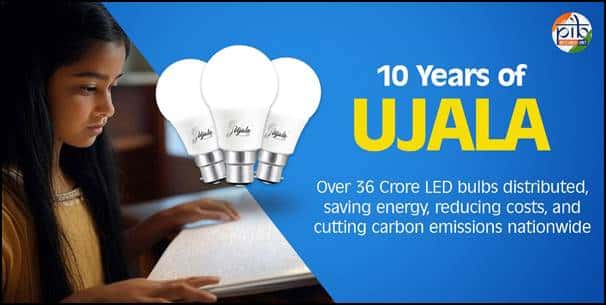UJALA Scheme: A Decade of Energy Efficiency

The UJALA scheme, launched on January 5, 2015, by Prime Minister Narendra Modi, has reached a significant milestone as it celebrates its 10th anniversary. Initially introduced as the Domestic Efficient Lighting Programme (DELP), UJALA has transformed into a pioneering initiative in energy efficiency. The scheme aims to revolutionize household lighting by providing affordable, energy-efficient LED bulbs, tube lights, and fans to millions of Indian homes. Over the past decade, more than 36 crore LED bulbs have been distributed across the country. This initiative has made energy-saving technologies accessible to households while addressing challenges such as high electrification costs and carbon emissions. Jointly undertaken by the Energy Efficiency Services Limited (EESL) and DISCOMs under the Ministry of Power, UJALA exemplifies India’s commitment to reducing energy consumption and enhancing environmental awareness. As it marks this significant milestone, the scheme stands as a testament to the power of collective effort in building a brighter, more sustainable future for the nation.
Illuminating Efficiency: The Need for UJALA
The UJALA scheme was conceived to tackle the pressing need for energy efficiency in Indian households. Traditional lighting systems consumed significant amounts of electricity, leading to high costs for consumers. For instance, a 7W LED bulb provides the same amount of light as a 14W Compact Fluorescent Lamp (CFL) and a 60W Incandescent Lamp (ICL). This means that LEDs save nearly 90% energy compared to ICLs and about 50% compared to CFLs.
Before the launch of UJALA, the retail price of an LED bulb was around Rs 450–500, which was significantly higher than a CFL priced at Rs 100–150 and an ICL at Rs 10–15. Consequently, the share of LEDs in the lighting market was less than one percent in 2013-14. This high initial cost posed a major barrier to adoption, highlighting the urgent need for an intervention to make LEDs affordable and accessible to the masses.
The UJALA scheme enables consumers to purchase LED appliances at significantly reduced rates: Rs 70 per LED bulb, Rs 220 per LED tube light, and Rs 1110 per energy-efficient fan. These prices were determined through competitive bidding, which included the cost of the appliance, distribution, awareness campaigns, and administrative expenses. In terms of energy consumption, an LED bulb uses only one unit of electricity when operated for 140 hours, while a CFL and an ICL consume two and nine units, respectively. This translates into substantial cost savings for consumers, making UJALA a vital initiative for transforming India’s lighting market into one that is sustainable, cost-effective, and energy-efficient.
UJALA’s Decade of Impact
As of January 6, 2025, the UJALA scheme has successfully distributed 36.87 crore LED bulbs, making it one of the most widely adopted initiatives in the country. Its implementation across all states has brought about transformative changes, significantly reducing annual household electricity bills. Consumers have saved money while improving their quality of life. The scheme has ensured transparency through e-procurement and fostered competition, which has significantly reduced transaction costs and time, leading to enhanced process efficiency.
The UJALA scheme has not only transformed the market but has also led to the sale of 407.92 crore LED bulbs in the Indian market. Beyond economic benefits, the scheme has made notable contributions to environmental sustainability by reducing the nation’s carbon footprint. These efforts align with India’s larger goals of energy conservation and climate change mitigation. Key outcomes of the UJALA scheme include substantial reductions in electricity consumption and a significant decrease in carbon emissions. These achievements underscore the scheme’s dual impact on economic development and environmental preservation, positioning it as a cornerstone of India’s energy efficiency journey.
Street Lighting National Programme (SLNP)
Launched on January 5, 2015, the Street Lighting National Programme (SLNP) was introduced alongside the UJALA scheme as part of the Government of India’s commitment to environmental protection and sustainable development. Prime Minister Narendra Modi envisioned this initiative, called “Prakash Path,” to replace conventional streetlights with smart, energy-efficient LED streetlights across the country. This initiative contributes to significant energy conservation and cost reduction in public lighting.
The aim of SLNP is to reduce energy consumption and operational costs for public lighting by replacing outdated street lamps with LED lights in urban and rural areas. Energy Efficiency Services Limited (EESL) was designated as the implementing agency for the programme. Collaborating with Urban Local Bodies (ULBs), Municipal Bodies, Gram Panchayats (GPs), and both Central and State Governments, EESL has been at the forefront of executing SLNP across India.
The programme introduced a unique business model that relieves municipalities of the burden of upfront investments. EESL handles the initial costs and recoups the investment through monthly or quarterly annuities paid by the municipalities throughout the project duration. As of January 6, 2025, EESL has successfully installed over 1.34 crore LED streetlights across ULBs and GPs. This has led to significant energy savings of over 9,001 million units (MUs) of electricity annually. The programme has also contributed to a reduction in peak demand by more than 1,500 MW and a decrease in CO₂ emissions by 6.2 million tonnes per year, highlighting its positive impact on energy efficiency and environmental sustainability.
Observer Voice is the one stop site for National, International news, Sports, Editor’s Choice, Art/culture contents, Quotes and much more. We also cover historical contents. Historical contents includes World History, Indian History, and what happened today. The website also covers Entertainment across the India and World.

